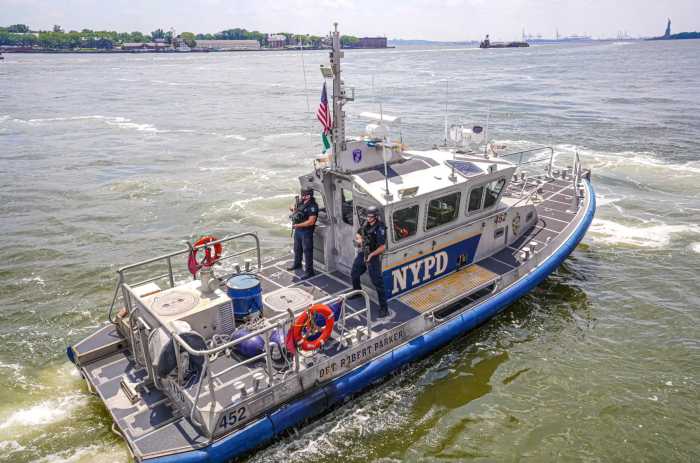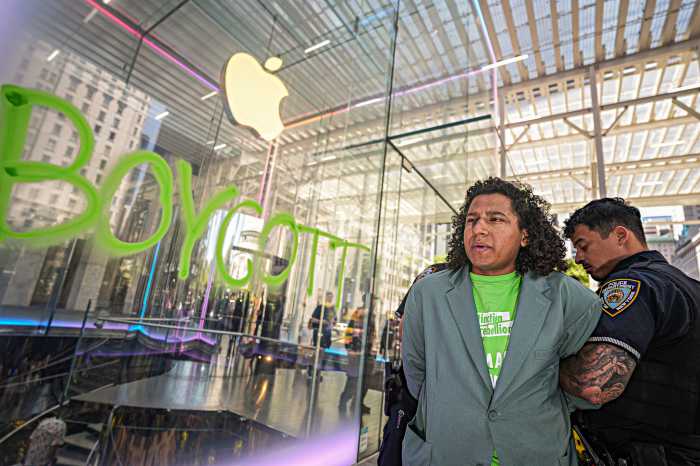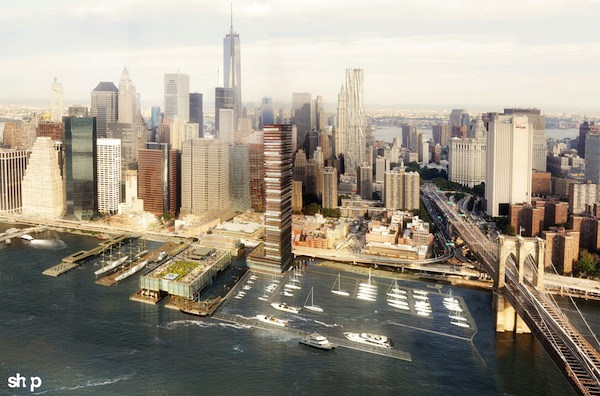
By JOSH ROGERS UPDATED 5;09 p.m. WITH COMMENTS FROM THE MAYOR |Opponents of the proposed 600-foot Seaport tower are looking to move the skyscraper further away from the neighborhood’s historic district.
The idea is to transfer unused development rights in the South Street Seaport Historic District just to the south on the East River, or to another part of Lower Manhattan, according to Gale Brewer, Manhattan’s borough president, and City Councilmember Margaret Chin, who both spoke at a meeting Monday night about a project that has been in limbo — at least publicly — since June.
Michael Kramer, a leader of Save Our Seaport, a neighborhood group that co-sponsored the meeting, told Downtown Express that an “upland” area under consideration is the so-called Greenwich Street South, just south of the World Trade Center.
Kramer said building a tower elsewhere would not only preserve the historic district’s character, it would provide revenue to save the South Street Seaport Museum, one of the major goals of the Seaport Working Group, a community panel that has worked with the developer, Howard Hughes Corp., and the city toward developing a better alternative.
“The ability to transfer unused air rights would be a boost to Chase Bank [the air rights owner] — it’s like found money,” said Kramer, who served on the working group, which was led by Brewer, Chin and others. “The museum could share it 50-50.”
Mayor Bill de Blasio, in response to Downtown Express questions about the tower and museum on Wednesday,said he’s agnostic regarding the merits of the current proposal, which would put the skyscraper adjacent to the historic district, but noted the need to build affordable housing.
“I don’t have any philosophical prohibition in my mind about putting a tower next to a historical district— this is New York City,” he said. “Throughout this city we have some extraordinary modern buildings right next to historic buildings….
“By the way it’s all case by case. The attitude we’re going to take — I said before we need to have much more affordable housing. In some cases that’s going to take taller and denser buildings, but it’s always about the specific site.”
The mayor also confirmed rumors that he’s taken a personal interest in saving the museum.
“I think the Seaport Museum is really crucial to the city and I think it has to be protected because this is how New York City became New York City,” de Blasio said at a Nov. 12 press conference at Lower Manhattan’s Spruce Street School. “We’re here because of the water, because of the maritime industry and I think it’s really important future generations feel that — so protecting the museum in some form is something I care about a lot. “
As for the tower, if it does move, there’s at least hundreds of thousands of square feet, if not millions, of air rights that have sat unsold for decades, mainly because the number of sites that can be sold to our limited.
One available site is on the water near Wall St. where Piers 13 and 14 used to sit with a private tennis club on top. Before he left office last year, Mayor Mike Bloomberg eyed the area as part of his Seaport City idea to build on the water as a storm protection plan. The de Blasio administration continues to study the idea of building out in the water, although the name “Seaport City” probably died with the last administration.
As for possibilities like Greenwich South, one source familiar with the discussions said there would be legal hurdles to clear in order to transfer the air rights to any place not slated to get Seaport air rights. Back in 2002, Bloomberg wanted to improve treacherous pedestrian areas around the Brooklyn-Battery Tunnel entrance and nearby garage, by decking over large sections with landscaping and development sites. The idea was later scrapped because it was too expensive, but elements of it had the strong support of community and business leaders.
Brewer, the borough president, said at the meeting that “there are conversations” about transferring the unused air rights.
In an apparent reference to these discussions with Howard Hughes, the city Economic Development Corp., which manages the city-owned project’s sites in question — the New Market and Tin Buildings — sent an email to be read at the meeting which, according to Kramer, said the city has been “working with the Howard Hughes Corp. to compose a holistic project that both addresses the recommendations developed by the [Seaport Working] Group and serves the needs of the Seaport community.”
The email also said a revised plan would be presented in the “coming weeks.” Hughes Corp.’s Chris Curry, who is in charge of the project said, the changes would come “very shortly.”
In brief remarks made at Monday’s meeting, Curry said the working group “was a very good process. I actually think we’ll have a better project because of it.” He probably won’t be surprised to hear about the mayor’s comment about affordable housing by the Seaport since he had said he received a similar message from de Blasio aides right before the administration took over in January/
Curry did not answer questions this week after the meeting. In its third quarter report released this week Hughes, a Dallas-based firm, said the plan would be out before the end of the year.
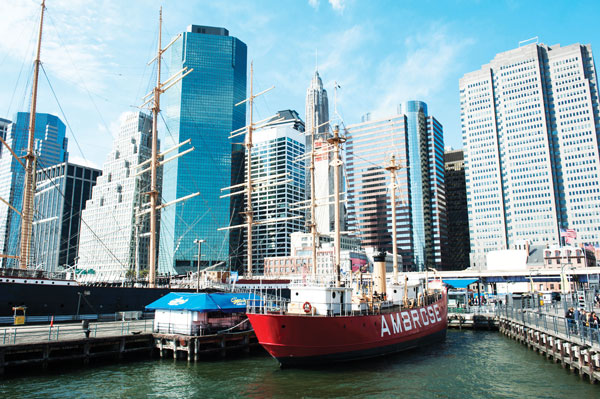
Chin said she is in no hurry to have the revisions completed, but wants to make sure that they follow the guidelines the working group wrote. She told Downtown Express of Hughes, that “if they’re exploring alternative options that’s great…. We’re asking the city to look at alternatives…”
Brewer said moving the tower would reduce the development costs.
“If you put a public market for instance in the Market Building or in the Tin Building then you don’t have to have as large a support system for that particular building… The museum has to paid for and [repairing] the pier has to be paid for….
We are not opposed to the tower paying for some of these wonderful aspects the museum and the pier in particular but we are not — at least I am not —supportive of the tower in the current location.”
Over the decades, the tennis bubble location near Wall St. has attracted artists, developers and mayors. The courts were made famous by Woody Allen, who set his character’s first meeting there with Diane Keaton in “Annie Hall.” Former Mayor Rudy Giuliani and the Guggenheim Museum had hoped to build a mega-museum designed by Frank Gehry that many likened to his famed Guggenheim in Bilbao, Spain, but the idea was shelved for cost reasons.
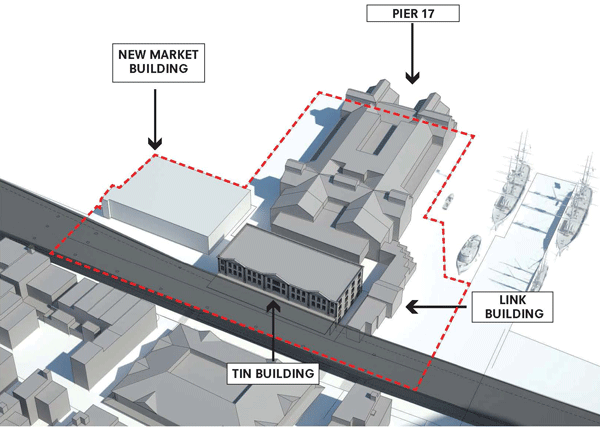
Schematic of the project areas, including the current tower site, the New Market Building, and the Tin Building. mage courtesy of the Howard Hughes Corp.



